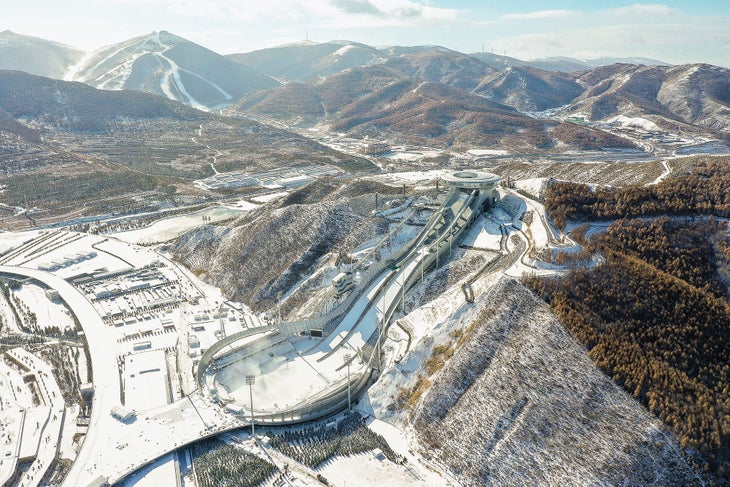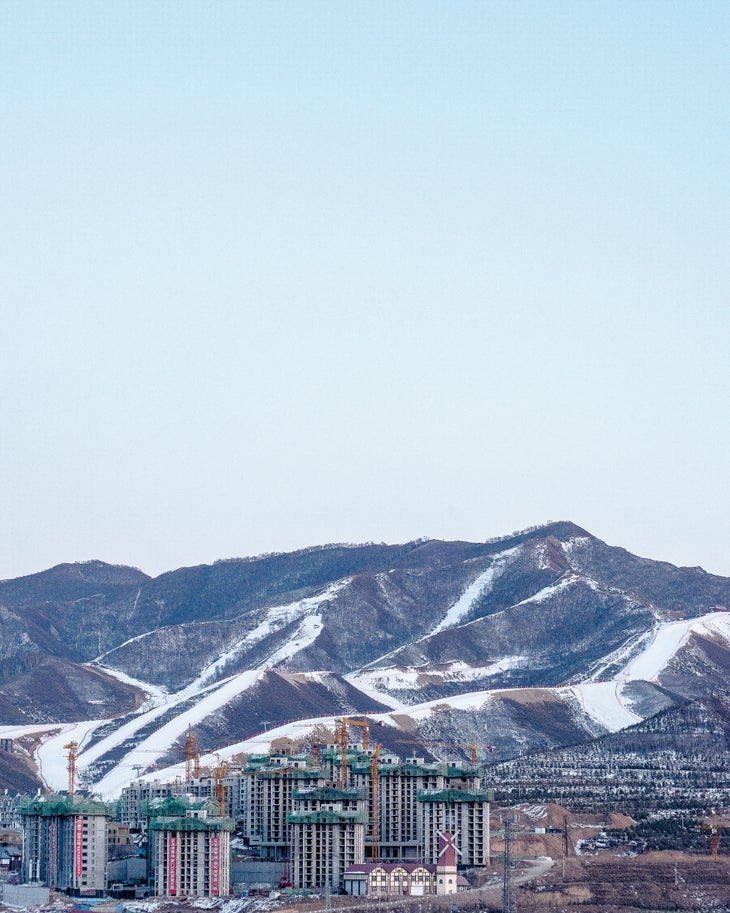Products You May Like
Receive $50 off an eligible $100 purchase at the Outside Shop, where you’ll find gear for all your adventures outdoors.
Sign up for Outside+ today.
A few years ago, when China was really in the thick of trying to become a state-sponsored winter sports nation, I was walking down a street in the town of Chongli about 100 miles northwest of Beijing, struggling to believe what I was seeing. It was late February, the third trip I’d made to the region in less than two years, and the pandemic had yet to hit. But in the four months since I’d last stood on this street along the murky Qingshui River, Chongli had become unrecognizable.
Fields once full of wild marijuana near a brand new ski resort called Thaiwoo were now erupting in great pillars of concrete and steel as workers erected a new depot for a bullet train that would cut down travel time from Beijing to Chongli from a painful 4.5 hours to about 50 minutes. Dusty roads where I’d watched pigs root in the gutters while hunting for a morning cup of coffee two seasons ago were now the glistening bottomlands of a tight canyon framed by walls of sparkling hotels, restaurants, apartment complexes, and shops. A light snow fell to glaze everything in a layer of ice, and the chaos of spun-out cars and penguin-waddling pedestrians was outstanding. It was as if after so much effort to build a ski town out of nothing, no one was still really sure what to make of the snow.

The “Joyful Rendezvous on Pure Ice and Snow” (yes, that’s the slogan for these Games), is about to begin in Beijing and all eyes are on China as it hosts the 2022 Winter Olympics from February 4 to 20. But unlike past Games, most of the world—and some boycotting Western diplomats—won’t be there to cheer, wander the venues, or even huddle around post-event hot spots thanks to restrictions that have barred most international travelers from the country since the pandemic erupted in March 2020. Even so, when the lights go down for the opening ceremonies in Beijing, the curtain will also rise on just how much the world of winter sports has been changing right under our noses.
“As a good Chinese friend recently told me, if you haven’t been to China in the last six months, you’ve never been to China,” says Scott Trepanier, senior director of international marketing for Columbia Sportswear, which was one of the first American outdoor companies to enter the Chinese market nearly 20 years go. “The pace of change is just that rapid and the same goes for the outdoor industry.”
Related: Diplomatic Boycott of the 2022 Beijing Winter Games Will Not Affect Athlete Participation
You may recall how it all began. On July 31, 2015, the International Olympic Committee awarded the 2022 Olympics to China, after every other country withdrew their bids except for Kazakhstan. From that moment forward it was game on in the Middle Kingdom. Directives from the highest levels of the Chinese government ordered banks to make financing easy for developers looking to build ski resorts and speculative second-homes, while planning commissions streamlined their approval processes to pretty much skip any environmental review at all. The country was basically a blank ski slate.
At that time, China, a country larger than the U.S. in size with four times as many people (1.44 billion and counting), had 109 ski areas with actual chairlifts—and Americans would consider only maybe five of those ski areas true ski resorts, with multiple lifts and runs and a place to sleep and get something to eat. But over the next five years, 10 new ski areas opened up on average each year. One of them, a place called Fulong right on the edge of Chongli’s central district, sprung up in literal months.
The fact that so many ski areas opened up virtually overnight mirrors the explosion in participation. Twenty years ago there were so few skier visits—maybe 50,000 per year, if that—that most Chinese had never seen a real pair of skis outside of television or the internet. The government wanted to jack that up to 350 million “winter sports enthusiasts” by the time the Games rolled around, but who knows how to really count that. What is clear is that in 2019, just months before the pandemic hit, China’s resorts logged a collective 21 million skier visits as skiing shows ran 24/7 on national TV channels and WeChat groups like “Little Snowman Club” exploded with people chatting about the sport (I receive about 480 posts an hour on it). Snowboarding, in particular, really took off.
“I was at Fulong last week and there were 3,000 people on the slopes and it was mid-week,” says Craig Smith, CEO of Burton China, adding that 85 percent of them were on snowboards. That makes sense since the mountains in this part of China only get a few inches of snow a year (let that sink in for a second), which makes zero difference to a park and pipe crowd. “The boom is not slowing down at all,” Smith says. “It’s just crazy.”

Only one of those new ski areas will be used for the Games, a place called Genting Secret Garden on the outskirts of Chongli, where the freestyle skiing and snowboarding events will take place on tongues of mostly manmade snow unfurling in the 7,000-foot-high peaks. The opening and closing ceremonies will happen in Beijing’s famous “Bird’s Nest,” the same legacy venue from the 2008 Beijing Summer Games, making it the only country to host both flavors of the Olympics.
One of the most unusual venues will host the big air competition and perhaps serves as a metaphor for the transformation underway in China. The Shougang District in Beijing was once a grim industrial complex, with blast furnaces and massive steel-making factories. Now athletes will be throwing themselves off a giant ramp built into the side of a 230-foot-tall defunct nuclear cooling tower. (Again, think about that for a moment.)
The alpine skiing events, meanwhile, will go down at a place on Xiaohaituo Mountain in northwest Yanqing, a distant Beijing suburb, where you’ll find seven runs. Those are part of a “sliding center” that will only be used for training purposes after the Games. Conditions here can get incredibly icy and the downhill course is extremely steep, dropping 2,995 feet off a knife ridge down into a canyon with very narrow shots. In one spot, a really, really bad fall could potentially generate enough force to send a skier hurtling into the safety fencing, that, should it fail, would see the athlete flying off a cliff. As Justin Downes, the president of a destination ski resort planning firm called Axis Leisure in Beijing, told me in 2018, “an Olympic downhill course isn’t something your average local skier would find attractive.”
To be respectfully blunt, managing such a challenging venue as the one in Yanqing could be difficult for Chinese ski patrollers alone because they simply do not have the long-standing institutional knowledge of other experts. The Chinese have basically been training for only three years. “They’ve accomplished a lot and it’s impressive,” says Zach Weinberg, a ski patroller from Bend, Ore., who is one of 26 American patrollers tapped to help Chinese patrollers provide safety and medical help at the alpine events. “I know they’ve practiced many scenarios and traveled to New Zealand to get training from Canadians, but they’ve never responded to an actual injured skier.”
Also Read: SkiMo Brings More Spandex to 2026 Olympics
How all of this is being perceived in China is a bit of a mystery to outsiders, though the more hard-bitten Chinese skiers I’ve met over the years are quick to separate the Games from the active outdoor lifestyle they’ve embraced. “The Olympics are just a government thing,” says Anna Li, whose name I’ve changed out of an abundance of caution. Her friend Adam Yi agrees. “It’s hard to get excited about something like this when the Games are basically closed.”
China doesn’t really need to prove anything to outside visitors either, with a domestic market so big and strong that it’ll fuel growth for decades. You will always have your weekend warriors more interested in the selfies than the snow, but legions of other Chinese will grow less interested in the manmade, manufactured experience and seek out the vast expanses of Xinjiang, the far western province, where the mountains are huge and the snow deep and plentiful. New resorts are already popping up out there, though they’re even hard for the Chinese to reach thanks to heavy government restrictions. This is the place, not the ski areas around Chongli, to go for world-class skiing.
But for Chinese skiers like Li and Yi, it’s what happens after the Olympic circus rolls out of town (and the pandemic finally ends) that gets them most excited. The thirst for healthy activities in nature, and the drive to explore the world through this relatively new sport—and other up-and-coming activities such as paddling, ultra-running and mountain biking—that’s what gets them excited.
“After skiing wild snow,” says Yi, using the Chinese expression for powder, “I just can’t be on a groomed run anymore. I’m planning my next trip now.”
